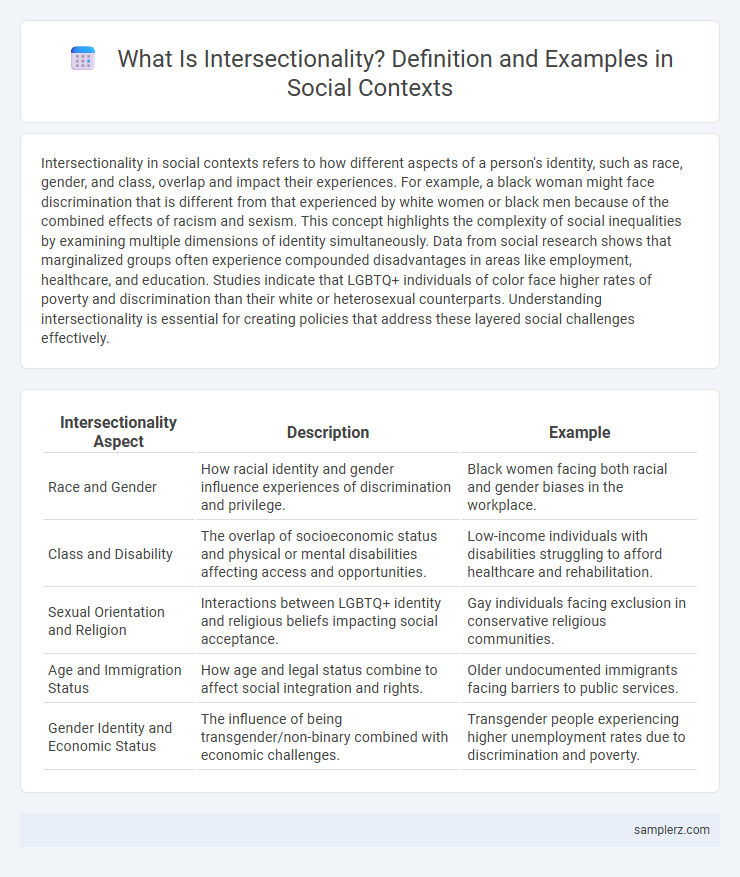Intersectionality in social contexts refers to how different aspects of a person's identity, such as race, gender, and class, overlap and impact their experiences. For example, a black woman might face discrimination that is different from that experienced by white women or black men because of the combined effects of racism and sexism. This concept highlights the complexity of social inequalities by examining multiple dimensions of identity simultaneously. Data from social research shows that marginalized groups often experience compounded disadvantages in areas like employment, healthcare, and education. Studies indicate that LGBTQ+ individuals of color face higher rates of poverty and discrimination than their white or heterosexual counterparts. Understanding intersectionality is essential for creating policies that address these layered social challenges effectively.
Table of Comparison
| Intersectionality Aspect | Description | Example |
|---|---|---|
| Race and Gender | How racial identity and gender influence experiences of discrimination and privilege. | Black women facing both racial and gender biases in the workplace. |
| Class and Disability | The overlap of socioeconomic status and physical or mental disabilities affecting access and opportunities. | Low-income individuals with disabilities struggling to afford healthcare and rehabilitation. |
| Sexual Orientation and Religion | Interactions between LGBTQ+ identity and religious beliefs impacting social acceptance. | Gay individuals facing exclusion in conservative religious communities. |
| Age and Immigration Status | How age and legal status combine to affect social integration and rights. | Older undocumented immigrants facing barriers to public services. |
| Gender Identity and Economic Status | The influence of being transgender/non-binary combined with economic challenges. | Transgender people experiencing higher unemployment rates due to discrimination and poverty. |
Everyday Life: Intersectionality in Social Interactions
Intersectionality shapes everyday social interactions by highlighting how overlapping identities such as race, gender, and class influence individual experiences and social dynamics. For example, a working-class Black woman may face unique challenges and biases in workplace conversations that differ from those encountered by her colleagues. These intersecting social categories affect communication patterns, access to opportunities, and the perception of social roles in daily life.
Intersectionality and Social Identity Formation
Intersectionality profoundly influences social identity formation by highlighting how overlapping social categories such as race, gender, class, and sexuality shape individual experiences and group dynamics. Social scientists use intersectional frameworks to analyze how multiple identities interact to produce unique modes of discrimination and privilege. This approach enables a deeper understanding of systemic inequalities and fosters more inclusive social policies and community practices.
Workplace Dynamics: Gender, Race, and Class Intersect
Workplace dynamics reveal complex intersectionality where gender, race, and class converge to influence experiences of discrimination and opportunity. Women of color from lower socioeconomic backgrounds often face compounded biases that limit career advancement and access to resources. Addressing these overlapping identities is essential for promoting equitable workplace policies and inclusive environments.
Intersectionality in Education: Barriers and Opportunities
Intersectionality in education reveals how overlapping social identities, such as race, gender, and socioeconomic status, create unique barriers to learning and academic achievement. Students from marginalized backgrounds often face compounded challenges like limited access to resources, discrimination, and lower expectations, which hinder educational outcomes. Recognizing these intersecting factors enables educators to develop inclusive policies and targeted interventions that promote equity and opportunity for all learners.
Social Movements and the Power of Intersectional Activism
Social movements highlight the power of intersectional activism by addressing the interconnected struggles faced by marginalized communities, such as the combined fight for racial justice, gender equality, and LGBTQ+ rights. Activists leverage intersectionality to create inclusive platforms that recognize overlapping identities and systemic oppressions. This approach fosters solidarity and amplifies diverse voices, driving more comprehensive social change.
Healthcare Inequities: Layers of Disadvantage
Healthcare inequities exemplify intersectionality through overlapping factors such as race, gender, socioeconomic status, and disability, which collectively limit access to quality medical services. Studies show that Black women with low income face higher maternal mortality rates compared to their white counterparts, demonstrating compounded disadvantages. These layers of disparity highlight the need for policies addressing multiple social determinants simultaneously to achieve equitable healthcare outcomes.
Media Representation: Multiple Identities, One Narrative
Media representation often showcases intersectionality by portraying characters who embody multiple identities, such as race, gender, and class, within a single narrative. This approach highlights the complexity of lived experiences and challenges monolithic stereotypes, fostering a more inclusive understanding of diverse social realities. Emphasizing intersectional identities in media can promote empathy and awareness, influencing societal attitudes toward marginalized groups.
Urban Spaces: Navigating Intersectional Marginalization
Urban spaces reveal intersectional marginalization as individuals face overlapping disadvantages related to race, gender, class, and disability in public transportation, housing, and policing. For example, women of color often encounter heightened surveillance and violence in poorly lit neighborhoods, while low-income disabled residents struggle with inaccessible infrastructure. These compounded barriers highlight the importance of inclusive urban planning that addresses diverse social identities and unequal power dynamics.
Intersectionality in Policy and Social Justice Initiatives
Intersectionality in policy and social justice initiatives highlights how overlapping identities such as race, gender, and socioeconomic status impact individuals' experiences of discrimination and access to resources. Policies that incorporate intersectional frameworks address systemic inequalities by considering multiple dimensions of marginalization, leading to more inclusive and effective social programs. Social justice movements leveraging intersectionality work to dismantle barriers faced by marginalized communities, promoting equity across diverse populations.
Technology and Online Communities: Intersecting Experiences
Technology and online communities reveal intersectionality through how race, gender, and socioeconomic status shape digital access and participation. Women of color often face amplified discrimination and harassment in tech spaces, limiting their engagement and representation. Economic disparities further influence who benefits from digital opportunities, creating layered challenges within virtual environments.

example of intersectionality in social Infographic
 samplerz.com
samplerz.com